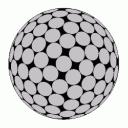Yahoo Answers is shutting down on May 4th, 2021 (Eastern Time) and beginning April 20th, 2021 (Eastern Time) the Yahoo Answers website will be in read-only mode. There will be no changes to other Yahoo properties or services, or your Yahoo account. You can find more information about the Yahoo Answers shutdown and how to download your data on this help page.
Trending News
Does a triangular hectare with integer sides exist?
I want to buy a triangular piece of land with area exactly 1 hectare and sides that are exactly positive integers when measured in meters. Could such a piece of land exist? If yes, please give explicit examples. If no, please provide proof.
@Madhukar Daftary: all three sides have to be positive integers.
@Duke: life is full of compromises. I may have to make do with a plot 125m by 160m by 203m. :(. I have no doubt about the divisibility by 6 you mention, but is your proof affected by the fact that k,m,n are rational rather than integer, and many Heron triangles with integer sides do not appear if you restrict k,m,n to integers?
@gianlino: I guess you mean N^2 = k*m*n(m-n)(m*n - k^2). There seem to be infinitely many, (m,n,k) = (1,8,2) gives N=24, (m,n,k)=(1,9,2) gives N=30, etc. But such triangles do not have relatively prime sides. With regard to "square Heron triangles" see my answer to another question: http://ca.answers.yahoo.com/question/index?qid=201...
@gianlino 2: Oops! Make that N^2 = mnk(m+n)(mn-k^2). Now (m,n,k,N) = (1,8,2,24), (1,9,2,30) should check out. The next one is (3,6,4,36) and the one after that is (8,9,2,408).
@Duke 2: The "treasure" with greater accuracy is 9999.9991 999999 6799999 743 9999 743 9999 713. In addition to the triangle with sides 5,5,6 mentioned by gianlino, the triangles 5,5,8; 4,13,15; 5,12,13; 3,25,26; 9,10,17 and infinitely many more are missed if m,n,k are restricted to integers.
@gianlino 3: other triangle shapes:
[m, n, k], [a, b, c], N^2, [a, b, c]_reduced, reduced_area
[5, 45, 3], [1530, 10170, 10800], 2700^2, [17, 113, 120], 30^2
[15, 25, 9], [7650, 10590, 11760], 6300^2, [255, 353, 392], 210^2
[20, 25, 4], [10400, 12820, 21780], 6600^2, [520, 641, 1089], 330^2
[21, 28, 9], [14616, 18165, 24843], 11466^2, [696, 865, 1183], 546^2
[25, 40, 26], [52040, 56900, 21060], 23400^2, [2602, 2845, 1053], 1170^2
[32, 49, 14], [59780, 83104, 111132], 49392, [305, 424, 567], 252^2
[48, 50, 45], [216450, 217200, 36750], 63000, [1443, 1448, 245], 420^2
Nice observations on right and isosceles triangles.
@falzoon: great find of treasure 2.
@gianlino: I didn't do any of the computations by hand. I asked the question because I thought others might have fun with it, and because I didn't know about the divisibility by 6. I learned a lot from both your and Dukes' answers -- thank you.
@Duke: very clear and detailed proof. Many thanks.
3 Answers
- DukeLv 71 decade agoFavorite Answer
(Revised answer - I deleted some text not to run out of space)
My initial answer was that an integer Heronian triangle with area 10000 does not exist because its area A is divisible by 6 (I have a faint reminiscence that I have encountered that statement about integer Heronian triangles somewhere very long ago - curiously the Pythagorean triangles have the same property) and 10000 is not.
The initial attempt used the expressions for the side lengths and area in these articles:
http://en.wikipedia.org/wiki/Heronian_triangle#Exa...
http://mathworld.wolfram.com/HeronianTriangle.html
from which the above statement follows easily. But both JB and Gianlino kindly pointed to me, that these expressions do not yield ALL integer Heronian triangles if the parameters m, n, k are integers (many thanks to both of them!), so the initial proof is unacceptable, not being universal. Sorry, my fault, I'll read articles more carefully from now on, have ordered a pair of stronger glasses already.
Nevertheless it turns out that 6 | A is true. Indeed let a, b, c, A are the integer side lengths and integer area, then
(*) (a + b + c)(a + b - c)(b + c - a)(c + a - b) = 16A²
STATEMENT 1: 3 | A. Proof (all congruences below are by modulo 3):
- if a ≡ b ≡ c then a + b + c ≡ 0 and LHS of (*) is divisible by 3;
- if a ≡ b ≡ 0 and c ≡ 1, then LHS ≡ 1*(-1)*1*1 ≡ -1: impossible, since no perfect square is congruent to -1;
- if a ≡ b ≡ 0 and c ≡ 2, then again LHS ≡ -1: impossible;
- if a ≡ 0 and b ≡ c, then a + b - c ≡ 0;
- if a ≡ 0, b ≡ 1, c ≡ 2, then a + b + c ≡ 0;
- if a ≡ b ≡ 1 and c ≡ 2, then a + b - c ≡ 0;
- if a ≡ b ≡ 2 and c ≡ 1, then a + b - c ≡ 0;
So LHS is divisible by 3, hence 3 | RHS and 3 | A.
STATEMENT 2: 2 | A. The proof is somewhat lengthy and uses the following
LEMMA: if a', b', c' are odd integers, or only one of them is odd, then the expression
E = (a' + b' + c')(a' + b' - c')(b' + c' - a')(c' + a' - b') ≡ 3 (mod 4), so can not be a perfect square. Proof of the LEMMA (all congruences below are by modulo 4):
Case 1) a', b', c' odd:
- if a' ≡ b' ≡ c' ≡ 1 or a' ≡ 1 and b' ≡ c' ≡ 3, then E ≡ 3*1*1*1 ≡ 3;
- if a' ≡ b' ≡ c' ≡ 3 or a' ≡ b' ≡ 1 and c' ≡ 3, then E ≡ 1*3*3*3 ≡ 3;
Case 2) only a' odd is treated similarly examining all combinations of residues and again E ≡ 3.
Proof of the STATEMENT 2: the idea is to show that the LHS of (*) is divisible at least by 2⁶, the latter implies the same about 16A², and A will be even. Obviously among a, b, c are 0 or 2 odd, otherwise LHS would not be divisible by 16. All congruences below are by modulo 4:
- if a ≡ b ≡ ±1 and c ≡ 2, then LHS is divisible by 4*4*2*2;
- if a ≡ b ≡ ±1 and c ≡ 0, then LHS is divisible by 2*2*4*4;
- if a ≡ 1, b ≡ -1, c ≡ 2, then LHS is divisible by 2*2*4*4;
- if a ≡ 1, b ≡ -1, c ≡ 0, then LHS is divisible by 4*4*2*2;
- if a ≡ b ≡ c ≡ 0, then LHS is divisible by 4*4*4*4;
- if a ≡ b ≡ 2, c ≡ 0, then LHS is divisible by 4*4*4*4;
- if a ≡ b ≡ c ≡ 2, then
a = 4a" + 2 = 2(2a" + 1), b = 4b" + 2 = 2(2b" + 1), c = 4c" + 2 = 2(2c" + 1)
denoting a' = 2a" + 1, b' = 2b" + 1, c' = 2c" + 1 we arrive to
16(a' + b' + c')(a' + b' - c')(b' + c' - a')(c' + a' - b') = 16A², but canceling by 16 reduces LHS to an expression of kind E above, which can not be a perfect square according the above LEMMA, Case 1). This combination of residues is impossible.
The last possibility a ≡ b ≡ 0, c ≡ 2 is also impossible, it leads similarly to Case 2) of the LEMMA.
Of course STATEMENT 1 alone (proved by Gianlino also) resolves the initial question, disproving the existence of such triangular hectare. Yet I am deeply impressed by the triangle 125 x 160 x 203 and by Falzoon's example - terrific achievements, congratulations!
But the statement 6 | A means that an integer Heronian triangle with A = 9999 also doesn't exist!
Many thanks for the patience and keeping the question open.
- gianlinoLv 71 decade ago
I thought computer people would disprove this first but algebra was faster.
You can still wonder which squares happen to be areas of triangles with integer sides or for which integers N, does N^2 = k*m*n(m + n)(m*n - k^2) have a solution with k,m,n integers with GCD(k,m,n) = 1
In the list given in Duke's link, only N = 6 works, but it's a short list.
Edit @JB. 1/ I mentioned to Duke the same reservation about rationals. He did not seem to see a serious objection there and in the list on his link, all areas are indeed multiples of 6 and the (m,n,k)'s can be rational.
You can also see it directly on Héron's formula
16 A^2 = p*(p-2a)*(p-2b)*(p-2c).
If p-2a, p-2b, p-2c are not multiples of 3, and p is not either, then mod 3, 2 classes of (p-a),(p-b),(p-c) are say 1, the last one being -1. Since the product is a square, the class of p must then be -1, but it also is the sum of the 3 others. Since +1 +1 -1 = 1, this yields a contradiction.
So A is a multiple of 3. I don't know about evenness but for your original q this is enough.
2/ You addressed the square question in the past but after having looked at your various answers and links, I can't say I got a very clear picture.
But here I don't get how (m,n,k) = (1,8,2) gives N = 24 or A = 576. Plugging into k*m*n(m-n)(m*n - k^2) doesn't seem to work. Same for N = 30 and (1,9,2).
Sorry typo, you meant (m + n) not (m - n).... right but then you just get multiples of the triangles found for N = 6.
Edit @Duke: It is not true that (m,n,k) integers give all Heronian triangles. For instance the triangle with sides 6,5,5 can't be attained with integers. In your link they only claim to get all similarity classes with integer parameters. Or did I misread?
Edit @JB2, All your examples work but give integer multiples of the solutions for N = 6 with sides (9,10,17) or (3,25,26). What about new shapes?
Edit The fact that no isosceles heronian triangle has a square area, follows easily from the fact that the equation A^4+B^4 = C^2 has no non zero integer solution. And is actually equivalent. The same goes for right triangles except this time the equation A^4 - B^4 = C^2 is involved (via parametrization of pythagorean triplets)
edit @JB3 If you do all this with just pencil and paper, hats off =) The question is: why with such power, did you ask this q in the first place...
- falzoonLv 71 decade ago
This is not an answer to your question, but trivially, to let you know, that for only an
additional 4 metres of perimeter, you could also have a plot, 110m x 185m x 197m, which has exactly the same area as your treasure, 125m x 160m x 203m.




